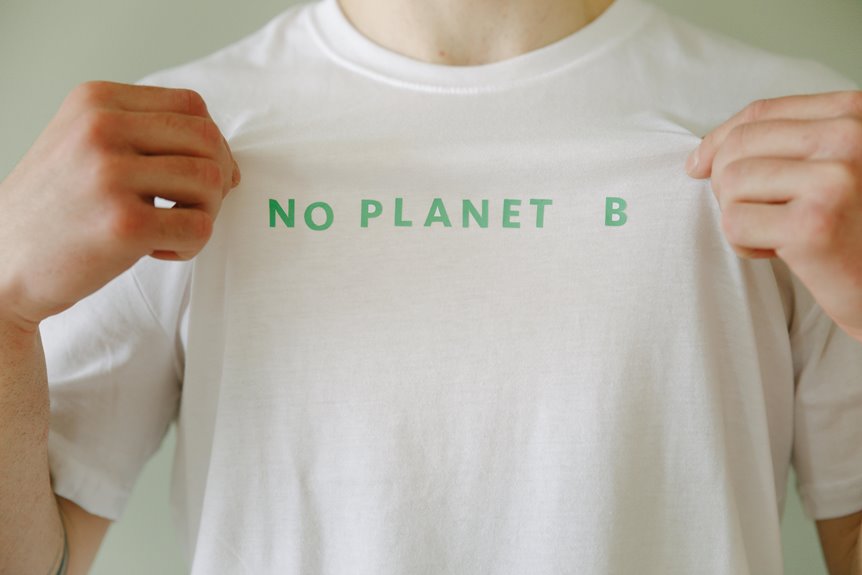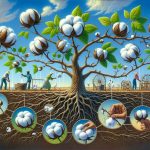When you consider the carbon footprint of various crops, hemp stands out for its impressive ability to absorb CO2. Its cultivation not only requires fewer chemicals but also thrives in less-than-ideal soil conditions. However, the textile production phase shows a different story, marked by higher emissions. Understanding this duality raises important questions about sustainability. What does this mean for the future of hemp in combating climate change?
Table of Contents
Key Takeaways
- Hemp cultivation absorbs up to 22 tons of CO2 per hectare annually, significantly reducing its overall carbon footprint.
- The cultivation phase has lower emissions due to reduced fertilizer and pesticide use compared to conventional crops.
- Processing hemp textiles generates higher emissions primarily due to energy-intensive methods used during production.
- Transportation of hemp products contributes to carbon emissions, especially when sourced from distant locations.
- Overall, hemp’s resource efficiency results in a lower carbon footprint compared to traditional textiles, promoting sustainable practices.
Carbon Sequestration Potential of Hemp
Hemp has a remarkable carbon sequestration potential, capable of absorbing up to 22 tons of CO2 per hectare annually.
When you consider cultivating hemp, you’re choosing a plant that not only grows quickly but also effectively captures carbon dioxide from the atmosphere. This ability helps mitigate climate change, making it a sustainable choice for various industries.
As you plant and nurture hemp, you’re contributing to a healthier ecosystem. Additionally, its deep root system enhances soil health, preventing erosion and promoting biodiversity.
By integrating hemp into your agricultural practices, you’re not just producing fibers; you’re actively participating in reducing greenhouse gases.
Embrace hemp cultivation, and you’ll find yourself part of a solution to combat environmental challenges.
Environmental Impact of Hemp Cultivation
While many crops can harm the environment through excessive use of pesticides and fertilizers, hemp cultivation stands out as a more sustainable alternative. It requires considerably fewer resources, thriving in diverse climates and poor soil conditions.
You’ll notice that hemp naturally repels pests, reducing the need for harmful chemicals. Plus, its rapid growth helps prevent soil erosion, promoting healthier ecosystems.
With a shallow root system, hemp also enhances soil structure, allowing for better water retention and nutrient cycling. This means that by choosing hemp, you support sustainable farming practices that nurture the land rather than degrade it.
Carbon Emissions in Hemp Textile Production
When you consider hemp textile production, it’s essential to recognize the carbon emissions involved in the process.
You’ll find that the resource efficiency of hemp can considerably reduce these emissions compared to other materials.
Plus, exploring end-of-life sustainability options can further minimize the environmental impact of hemp textiles.
Production Emission Overview
Carbon emissions play an essential role in understanding the environmental impact of hemp textile production. When you consider the entire process—from cultivation to processing—emissions can vary greatly.
Hemp’s growth typically requires fewer fertilizers and pesticides than conventional crops, which can lower emissions during cultivation. However, the processing phase often generates higher emissions due to energy-intensive methods used for transforming raw hemp into usable textiles.
Transporting hemp materials also adds to the carbon footprint, especially if sourced from distant locations.
Resource Efficiency Benefits
As you explore the resource efficiency benefits of hemp textile production, you’ll find that this versatile crop considerably reduces overall carbon emissions compared to conventional textiles.
Hemp requires less water and no pesticides, making it a sustainable choice. By choosing hemp, you contribute to a healthier planet and support innovative practices in textile production.
- It absorbs more CO2 during growth, lowering atmospheric carbon levels.
- The cultivation process is efficient, requiring fewer resources than cotton.
- Hemp’s durability means longer-lasting products, reducing waste.
- You’ll be part of a movement that prioritizes eco-friendly materials and sustainability.
Embracing hemp textiles helps you make a positive impact on the environment while enjoying stylish and high-quality products.
End-of-Life Sustainability Options
Although hemp textiles are known for their eco-friendly production, their end-of-life sustainability options further enhance their environmental benefits. By choosing hemp, you’re supporting a product that can decompose naturally, returning nutrients to the soil. Additionally, you can recycle or upcycle hemp textiles, minimizing waste and promoting a circular economy.
Here’s a quick overview of end-of-life options for hemp textiles:
| Sustainability Option | Description |
|---|---|
| Composting | Breaks down naturally, enriching soil. |
| Recycling | Transforming into new products. |
| Upcycling | Creative reuse for new purposes. |
| Donating | Extending the life of the garment. |
| Landfilling | Last resort, but still better than synthetic options. |
Resource Efficiency of Hemp Compared to Other Crops
When you compare hemp to other crops, you’ll notice its impressive resource efficiency.
It requires considerably less water and fewer pesticides, making it a more sustainable choice.
Plus, its rapid growth rate means you can harvest sooner, maximizing your yield while minimizing environmental impact.
Water Consumption Comparison
While many crops demand significant water resources, hemp stands out for its remarkable efficiency in water consumption.
It requires less water than cotton and many other traditional crops, making it a sustainable choice for farmers and the environment.
When you choose hemp, you’re not just opting for a versatile material; you’re also making a positive impact.
- Save precious water resources
- Reduce the strain on local aquifers
- Support sustainable agriculture practices
- Help combat climate change
Pesticide Use Reduction
Hemp not only thrives in diverse conditions but also requires considerably fewer pesticides compared to conventional crops like cotton and soy. This makes hemp a more environmentally friendly option for farmers.
When you choose hemp, you’re supporting practices that minimize chemical use, which benefits both the soil and surrounding ecosystems. Since hemp is naturally resistant to pests and diseases, it can grow effectively with less reliance on harmful chemicals.
This reduction in pesticide use not only lowers production costs but also aligns with growing consumer demand for sustainable and eco-friendly textiles. By embracing hemp cultivation, you’re contributing to a healthier planet and encouraging more sustainable agricultural practices.
It’s a win-win for you and the environment.
Growth Rate Advantages
One of the standout features of hemp is its rapid growth rate, which can reach maturity in just 90 to 120 days. This efficiency makes hemp a powerful contender among crops, allowing you to maximize land use and resources effectively.
Imagine the benefits this brings:
- Less land needed: Grow more in less space, helping combat deforestation.
- Faster yields: Harvest sooner, leading to quicker economic returns.
- Reduced water usage: Cultivate with less water, essential in water-scarce regions.
- Soil health: Hemp enriches the soil, promoting sustainability for future crops.
These advantages not only enhance resource efficiency but also contribute positively to environmental sustainability.
When you choose hemp, you’re making a choice for a greener future.
Economic Benefits of Hemp Cultivation
As you explore the economic benefits of cultivating hemp, you’ll discover its potential to boost local economies and create sustainable job opportunities.
Hemp farming can revitalize rural areas, offering farmers an alternative crop that requires fewer resources than traditional options. By investing in hemp, you’re supporting a versatile industry, from textiles to construction materials.
Moreover, hemp processing facilities generate jobs in manufacturing, logistics, and distribution, further enhancing community income. The growing demand for eco-friendly products means that businesses focusing on hemp will likely see increased profitability.
Plus, as hemp gains acceptance, export opportunities expand, contributing to a broader economic impact. Overall, hemp cultivation represents a promising avenue for economic growth and resilience.
Hemp as a Long-Term Carbon Sink
The potential of hemp goes beyond economic growth; it also plays a significant role in combating climate change. By absorbing carbon dioxide during its growth cycle, hemp serves as a long-term carbon sink, helping to mitigate greenhouse gas emissions.
Hemp is a powerful ally in the fight against climate change, acting as a long-term carbon sink.
Here’s why this matters:
- Sequestering carbon: Hemp can absorb up to 22 tons of CO2 per hectare annually.
- Sustainable cultivation: It requires fewer pesticides and fertilizers, reducing environmental impact.
- Versatile applications: From textiles to bioplastics, hemp offers eco-friendly alternatives that replace fossil fuels.
- Regenerative potential: Hemp promotes soil health, encouraging biodiversity and resilience.
When you choose hemp, you’re not just supporting a crop; you’re investing in a sustainable future that benefits our planet.
Life Cycle Assessment Methodology for Hemp Products
When evaluating the environmental impact of hemp products, applying a Life Cycle Assessment (LCA) methodology is essential. This thorough approach helps you analyze every stage of the product’s life, from cultivation through processing, usage, and disposal.
You’ll begin by defining the goal and scope, identifying the boundaries of your analysis. Next, collect data on resource inputs and emissions at each stage, focusing on energy use, water consumption, and greenhouse gas emissions.
Evaluate the potential environmental impacts using established categories, such as climate change and resource depletion. Finally, interpret your results to guide decision-making for sustainable practices in hemp cultivation and textile production.
Sustainable Applications of Hemp Beyond Textiles
While hemp is often celebrated for its textile applications, its potential extends far beyond fabrics. You might be surprised to learn how versatile this plant truly is.
Hemp’s versatility goes beyond textiles, offering a wealth of sustainable applications that can transform various industries.
Here are some sustainable applications of hemp that can inspire you:
- Biodegradable Plastics: Hemp can replace petroleum-based plastics, reducing pollution.
- Building Materials: Its fibers create strong, eco-friendly insulation and composites.
- Paper Production: Hemp paper requires less water and fewer chemicals than traditional paper.
- Health Products: Hemp seeds and oils are rich in nutrients, promoting wellness.
The Future of Hemp in Sustainable Agriculture
As consumers increasingly seek sustainable practices in agriculture, hemp stands out as a promising crop that can revolutionize the industry. Its rapid growth, low resource requirements, and ability to enrich soil make it an ideal choice for farmers looking to adopt eco-friendly methods. You’ll find that hemp can be used in various applications, from textiles to biofuels, making it a versatile option.
| Benefit | Description |
|---|---|
| Soil Health | Improves soil structure and nutrients |
| Water Usage | Requires less water than cotton |
| Carbon Sequestration | Absorbs CO2 during growth |
| Pest Resistance | Naturally repels pests without chemicals |
Embracing hemp in agriculture could lead to a healthier planet and a more sustainable future.
Frequently Asked Questions
How Does Hemp Cultivation Affect Local Biodiversity?
Hemp cultivation can enhance local biodiversity by providing habitats for various species. It supports pollinators and beneficial insects while reducing the need for chemical pesticides, promoting a healthier ecosystem. You’ll notice a vibrant environment flourishing around it.
What Are the Health Benefits of Using Hemp Products?
Using hemp products can boost your health by providing essential fatty acids, improving skin conditions, and offering anti-inflammatory properties. You’ll also benefit from its high fiber content, which aids digestion and supports overall wellness.
Can Hemp Be Grown in Different Climates?
Yes, you can grow hemp in various climates. It thrives in temperate regions but adapts well to different conditions. Just make certain it gets enough sunlight, proper soil, and adequate water for ideal growth.
What Are the Main Challenges in Hemp Farming?
You’ll face several challenges in hemp farming, like steering through strict regulations, dealing with pests, managing soil health, and ensuring proper irrigation. Each factor impacts your crop yield and overall sustainability in the industry.
How Does Hemp Compare to Other Carbon Offset Strategies?
When you compare hemp to other carbon offset strategies, you’ll find its rapid growth and ability to sequester carbon make it a strong contender. You can achieve significant environmental benefits through sustainable hemp farming practices.



